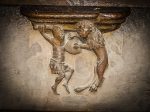The History and Mysteries of Europe’s Misericords Part II by Dave Douglas Davis
Misericord – or Mercy Seat – is the name of the ledge on the underside of the folding seats in the church’s choir stalls. Often hidden and usually unnoticed, these small seats meant a great deal for monks during their arduous day of worship.
Misericords as we know them first appeared in Germany in the 11th century. By the 13th century, they could be found in churches throughout Europe. They commonly were carved into a single panel of oak, although occasionally chestnut or another wood was used. The tradition fell into abeyance in England, Wales, and Ireland after the Dissolution of the Monasteries by Henry VIII in the mid-16th century.

Destruction of Misericords
On the continent, misericords continued to be installed for almost another century. However, a number of forces have conjoined to reduce the number of misericords that are preserved today. In countries that yielded to the new Protestant creeds, many were destroyed by reformers who regarded them as something akin to idols. In France during the Napoleonic wars, numerous misericords were removed from Catholic churches along with other carved wood to help satisfy the demand for oak to use in ship building.
Throughout Europe, the mercy seats – regarded by many as secular objects – were sometimes removed by local residents for use as firewood, or as fuel for cooking. Considering the significant destruction that took place, what is really noteworthy is how many misericords still exist in their original settings. Based upon the most comprehensive databases, we know that they number over 10,000. About half of these are in France and the United Kingdom, where they have been recorded in over 330 churches and other ecclesiastical buildings (split about evenly between the two countries), and in a handful of museums and other secondary settings.
- Knight battling a lion, Magdeburg Cathedral, Germany. Courtesy misericords.co.uk
- Dancing woman, Magdeburg Cathedral, Germany. Courtesy misericords.co.uk
Pan-european peculiarity
Smaller, but significant numbers of misericords can be found in churches and other religious buildings in various cities in Belgium, Denmark, Germany, Ireland, Italy, the Netherlands, Portugal, Russia, Spain, Sweden, and Switzerland. The two largest online databases of misericords and their locations are the extensive set of photographic images assembled by the late Prof. Elaine C. Block, now housed at Princeton University and the smaller, but substantial descriptive and photographic, database developed and maintained at this Misericords Website.
- Samson with the lion. Bristol Cathedral, United Kingdom. Courtesy misericords.co.uk
- Man drinking. Le-Puy-Notre-Dame Church, France. Courtesy Elaine C. Block collection.
The men behind Misericords
The names and information of the carvers themselves are almost never preserved in historical records. What is indisputable, though, is these craftsmen honed their talents through long periods of apprenticeship. Given what we know about artisans generally in Medieval times, we can safely assume that many (and perhaps most) were the sons and grandsons of carvers who learned much of their craft from senior family members. It was a skill in which one could take some pride, and indeed woodcarvers occasionally are depicted as subjects of misericords.
This was the age of guilds, and in cities where those organizations were prevalent, skilled carvers would certainly have belonged to one. After achieving recognition as journeyman, the best among them could one day become masters, and the very best, grandmasters. It was men of these high accomplishments who could hope to be entrusted with the design and oversight of the interior woodcarving for an abbey, or even for so grand a sacred edifice as a cathedral.

It seems safe to assume that whoever carved the misericord wouldn’t fashion anything without approval from the master carvers who designed and oversaw the projects. The carvings must also have had at least the tacit approval of the clerics who commissioned the work. After all, any prior or abbot who commissioned the design of an abbey or local church might expect to be called to account for its contents by his diocesan bishop, and the bishop in turn by his archbishop or his cardinal. So it seems likely that few if any of the images depicted in misericords were truly frivolous and without broader purpose. Yet, considering the widening gulf that separates us from our Medieval forebears, we can’t be certain that modern researchers will ever be able to tease out all the meanings that misericords conveyed.

Embarking upon a Misericord mission?
A cautionary note to the adventurous souls who would launch off on a mission to see and photograph misericords in their church settings: it’s not always easy. Churches with misericords that offer guided tours to the public do sometimes offer a viewing of the choir stall carvings. However, in many churches that are open to the public, the chancel, and especially the quire, are often corded off to discourage access by visitors.
Oftentimes, these physical barriers are reinforced by signs enjoining the public to keep out. If you want to remain welcome in the church, the best advice is to err on the side of caution. And if your newfound love of misericords drives you forward anyway, take the trouble to contact the local officials in charge in advance of your visit.
If you want to know how the misericords gave relief to the medieval monks, read the first part of Hidden Beneath the Seats – Père Dominique’s tale. In our third and last part of Hidden Beneath the Seats – The Artisan’s Playground we’ll explore the iconography of misericords. From religious and mythological to downright bawdy illustrations in the Mercy Seats in Europe.
Learn more






